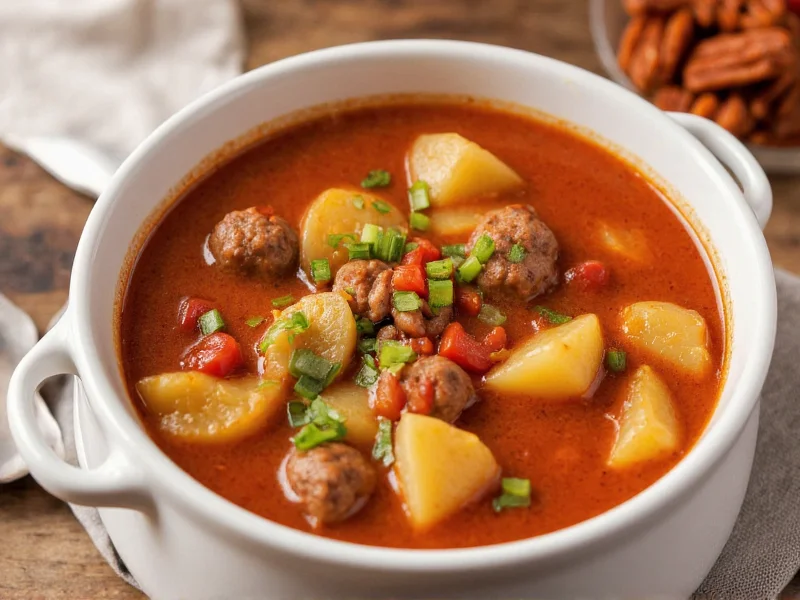Creating a delicious potato and hamburger soup starts with browning quality ground beef. This foundational step develops rich flavors that permeate the entire dish. The best versions balance hearty vegetables with tender potatoes and well-seasoned broth. Unlike many soup recipes that require specialty ingredients, this classic comfort food uses pantry staples most home cooks already have on hand.
Essential Ingredients for Perfect Potato Hamburger Soup
Quality ingredients make the difference between ordinary and exceptional soup. For an authentic potato and hamburger soup experience, gather these components:
| Category | Ingredients | Quantity |
|---|---|---|
| Protein | Ground beef (80/20) | 1 pound |
| Vegetables | Yukon Gold potatoes | 4 cups, diced |
| Vegetables | Carrots | 1 cup, sliced |
| Vegetables | Celery | 1 cup, chopped |
| Vegetables | Yellow onion | 1 medium, diced |
| Liquid | Beef broth | 4 cups |
| Seasonings | Garlic powder | 1 tsp |
| Seasonings | Dried thyme | 1 tsp |
| Seasonings | Salt and pepper | To taste |
Step-by-Step Preparation Guide
Follow these straightforward instructions for a consistently delicious potato hamburger soup:
- Brown the beef: In a large pot over medium-high heat, cook ground beef until no pink remains, approximately 8-10 minutes. Drain excess fat.
- Sauté vegetables: Add onions, carrots, and celery to the pot. Cook until vegetables soften, about 5 minutes.
- Add liquids and seasonings: Pour in broth, then add potatoes, garlic powder, thyme, salt, and pepper.
- Simmer: Bring to a boil, then reduce heat to low. Cover and simmer for 20-25 minutes until potatoes are fork-tender.
- Final seasoning: Taste and adjust salt and pepper as needed before serving.
Pro Tips for Superior Results
Elevate your homemade hamburger soup with potatoes using these professional techniques:
- Potato selection matters: Yukon Gold potatoes maintain their shape better than russets during cooking while adding natural creaminess
- Layer flavors: Deglaze the pot with a splash of broth after browning the beef to capture all the flavorful browned bits
- Texture control: For thicker soup, mash some potatoes against the pot side; for thinner broth, add additional liquid
- Acidity balance: A teaspoon of tomato paste or Worcestershire sauce enhances depth without making the soup taste tomato-based
Variations to Customize Your Soup
Personalize this classic American hamburger soup with potatoes to suit different preferences:
- Creamy version: Stir in ½ cup heavy cream during the last 5 minutes of cooking for a richer texture
- Vegetable boost: Add 1 cup frozen peas or corn during the final 5 minutes for extra nutrition
- Spicy kick: Include ¼ teaspoon cayenne pepper or a dash of hot sauce for heat lovers
- Herb freshness: Garnish with chopped fresh parsley or chives just before serving
Storage and Reheating Instructions
Potato and hamburger soup stores exceptionally well, making it ideal for meal prep:
- Refrigeration: Cool completely and store in airtight containers for up to 4 days
- Freezing: Freeze portions for up to 3 months (note: potatoes may become slightly grainy after thawing)
- Reheating: Warm on stove over medium-low heat, stirring occasionally. Add broth if soup has thickened too much during storage
Nutritional Profile
A standard serving (1½ cups) of this ground beef and potato soup preparation contains approximately:
- Calories: 280
- Protein: 18g
- Fat: 12g (saturated fat: 5g)
- Carbohydrates: 25g
- Fiber: 3g
- Sodium: 650mg (varies based on broth used)
Frequently Asked Questions
Can I use leftover hamburger patties in potato soup?
Yes, you can substitute cooked hamburger patties for raw ground beef. Chop the patties into small pieces and add them during the final 10 minutes of cooking to prevent overcooking. This works well for using leftovers but may result in slightly less integrated flavors compared to browning fresh ground beef.
Why do my potatoes turn mushy in hamburger soup?
Potatoes become mushy when overcooked or when using varieties with high starch content. To prevent this, cut potatoes to uniform ½-inch pieces, add them after browning the beef, and simmer just until fork-tender (about 20-25 minutes). Yukon Gold potatoes hold their shape better than russets in soups.
What's the best broth for potato and hamburger soup?
Beef broth provides the most complementary flavor for hamburger soup, but chicken broth works well too for a lighter taste. For best results, use low-sodium broth so you can control the salt level. Homemade broth yields superior flavor, but quality store-bought options like Swanson or Pacific Foods work well for quick preparation.
How can I make potato hamburger soup thicker without flour?
To thicken potato and hamburger soup naturally, remove 1-2 cups of soup (primarily potatoes and broth), mash the potatoes, then return the mixture to the pot. Alternatively, blend a portion of the soup with an immersion blender for a creamier texture while maintaining all ingredients. This technique works better than flour for gluten-free preparations.











 浙公网安备
33010002000092号
浙公网安备
33010002000092号 浙B2-20120091-4
浙B2-20120091-4